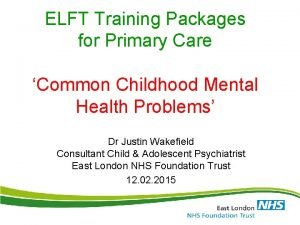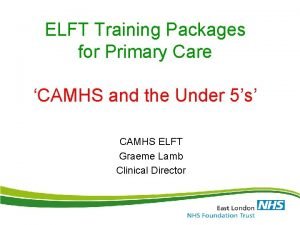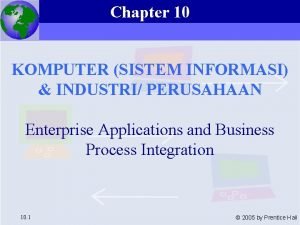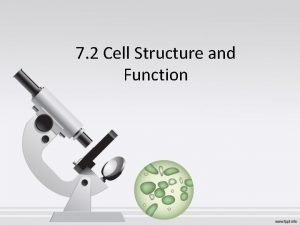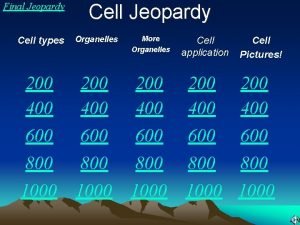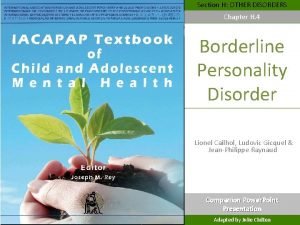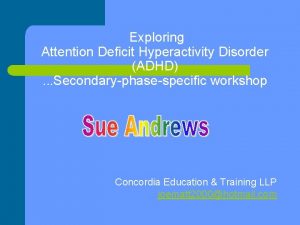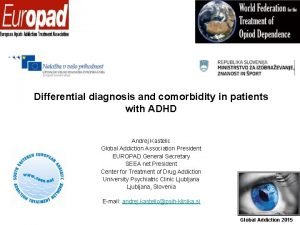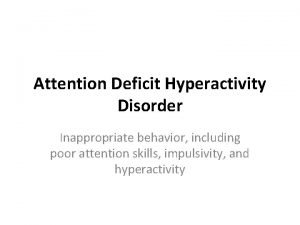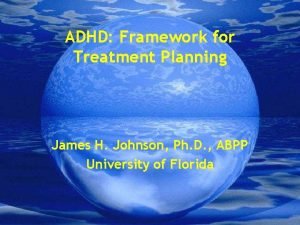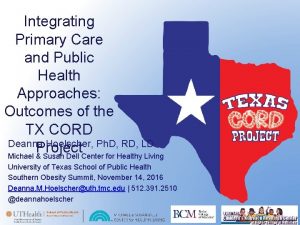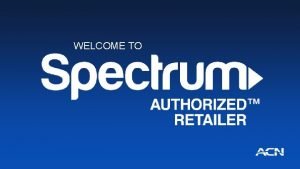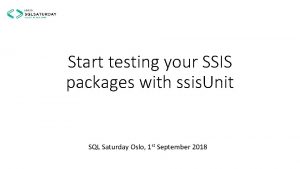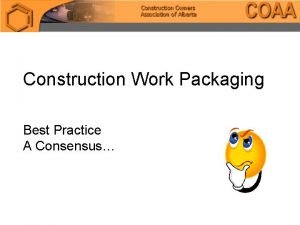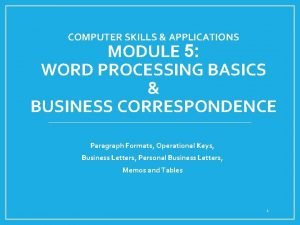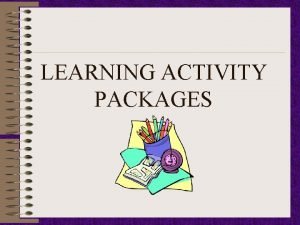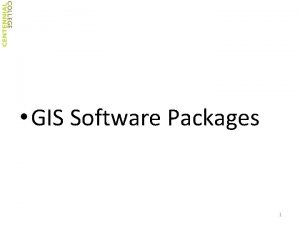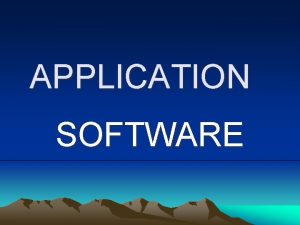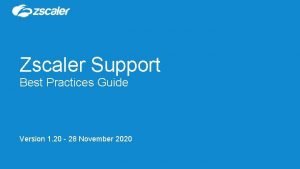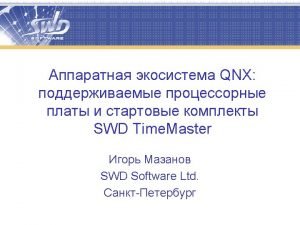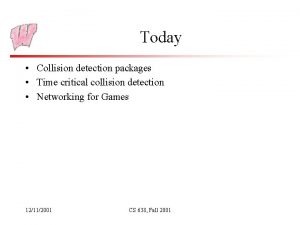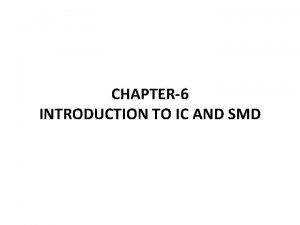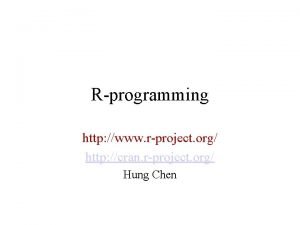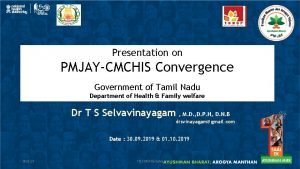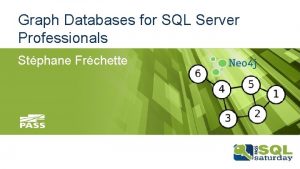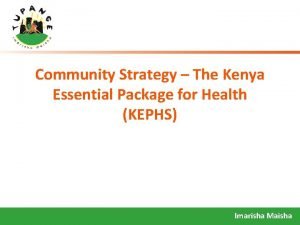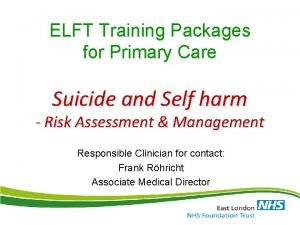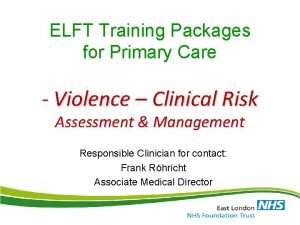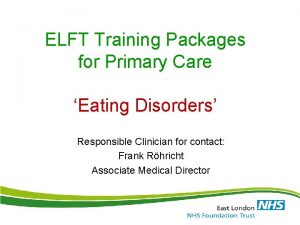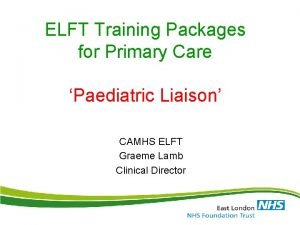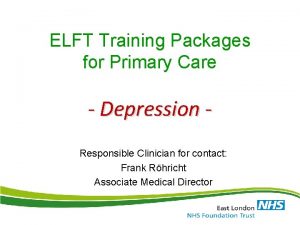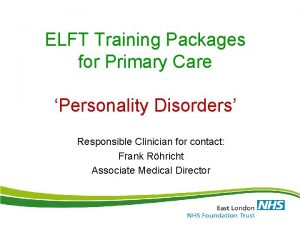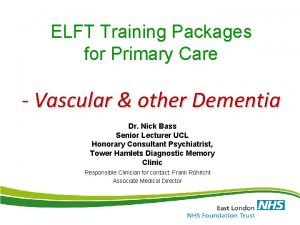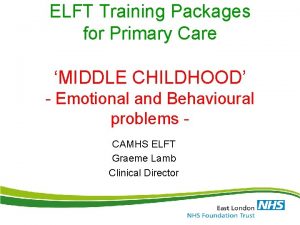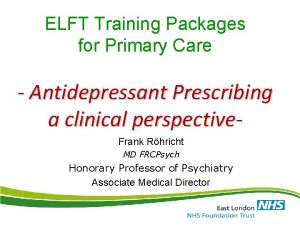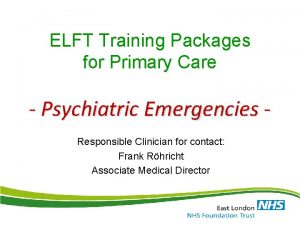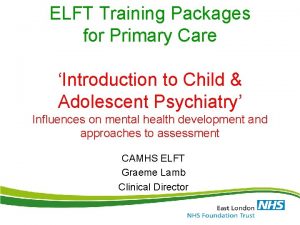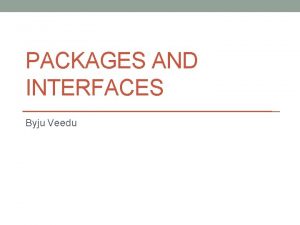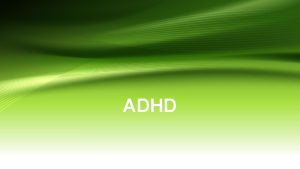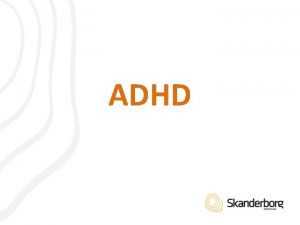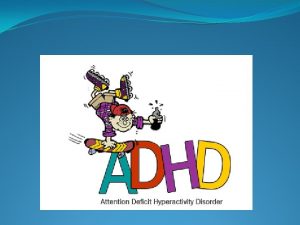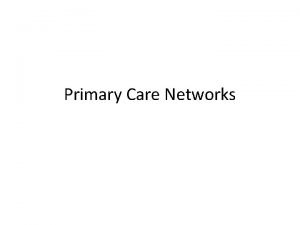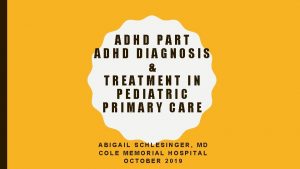ELFT Training Packages for Primary Care ADHD and











































































- Slides: 75

ELFT Training Packages for Primary Care ADHD and autism Responsible Clinician for contact: Frank Röhricht Associate Medical Director

What is ADHD? Inattention Hyperactivity Impulsivity

Symptom groups Inattention Hyperactivity Impulsivity • Does not pay attention • Fidgets • Talks excessively • Avoids sustained effort • Leaves seat in class • Blurts out answers • Doesn’t seem to listen • Runs/climbs excessively • Cannot await turn when spoken to • Cannot play/work quietly • Interrupts others • Fails to finish tasks • Always ‘on the go’ • Intrudes on others • Can’t organise • Talks excessively • Loses things, ‘forgetful’ • Easily distracted

Also…… • • • Present for >6/12 Present from before age of 6 -7 years Pervasive across settings Causing significant impairment Not better explained by alternative diagnosis

Developmental impact of ADHD Behavioural disturbance Academic problems Difficulty with social interactions Self-esteem issues Legal issues, smoking and injury Pre-school School-age Behavioural disturbance Academic problems Difficulty with social interactions Self-esteem issues Occupational failure Self-esteem issues Relationship problems Injury/accidents Substance abuse Adolescent College-age Adult Academic failure Occupational difficulties Self-esteem issues Substance abuse Injury/accidents

Just a childhood disorder? • Inattention persists in 50 -60% – If 5 -10% in children, then 3 -6% in adults • Impact in adults – Socioeconomic • Academic, employment, relationships, driving – Psychological • Low self-esteem, unhappiness, ‘ups and downs’, stress • Comorbidities MSc in Family Medicine Programme

Diagnostic criteria (DSM-IV-TR) – – Inattention symptoms Hyperactivity/impulsivity symptoms Before 7 y/o Impairment in at least two settings (study, work, relationships, family/friends etc. ) – Can’t be better explained by another disorder • Consider amending the criteria for adults – Reduce severity/number of required symptoms – Increase variety of symptoms, less hyperactivity, more inattention MSc in Family Medicine Programme

Diagnostic Criteria Hyperkinetic Disorder • ICD-10 • Inattention and hyperactivity/impulsivity • 6/12 + • < 6 years • Symptoms present in > 1 setting • Significant impairment • Absence of other disorder • 1. 5% prevalence ADHD • DSM-IV • Inattention and/or hyperactivity/impulsivity • 6/12 + • < 7 years • Some impairment in > 1 setting • Significant impairment • Not better explained by another disorder • 5% prevalence

Diagnosis • • • NICE Sept 2008 Should only be made by a specialist psychiatrist, paediatrician or other healthcare professional with expertise in ADHD Full clinical and psychosocial assessment Full developmental and psychiatric history Observer reports and MSE Assessment of needs, comorbidity, psychosocial circumstances, physical health Assessment of parents’ mental health

ADHD Assessment - Newham CFCS 1. 2. 3. 4. 5. 6. 7. family interview child interview physical examination psychometric assessment school liaison +/- classroom observation parent and teacher rating scales feedback to parent and child

1. Family interview • • History of presenting complaint Information about school performance Assess for alternate or co-morbid disorders Obstetric history Developmental history Family history and functioning Past Medical / Psychiatric history Observations within the session

2. Child interview • functioning within the family, school and peer group • general evaluation of psychopathology • child’s attitude to and coping with their difficulties • • social skills deficits ability to concentrate and persist evidence of language disorder Internalising symptoms

3. Physical examination • Assessment of underlying medical problems contributing to presentation • Assessment for potential contraindications to pharmacological intervention • Baseline measurements of height, weight and blood pressure may be conveniently completed at this time The child should be accompanied by their parent or carer for such examination

4. Psychometric assessment • no psychological test which decisively characterises ADHD • basic assessment of the child’s cognitive functioning • more formal psychometric testing (eg WISC) if cognitive delay suspected

5 a. School - liaison Talk to class teacher or SENCO • Information re core ADHD symptoms • Other symptoms • Peer and adult relationships • Learning • Statement / Level of extra help provided • Teacher’s opinion of problem behaviour

5 b. School - observation Observation of 2 different types of activity e. g. structured work and playtime. • Symptoms of overactivity and inattention • Attention-seeking behaviour • Peer relationships • Baseline activity level of whole class • Actions of teaching staff to help contain behaviour • Is this a typical day for this child?

6. Rating scales • Parent Strengths & Difficulties Questionnaire (SDQ) Conners Parent Rating Scale (Short or Long) • Self SDQ Conners-Wells’ Self-Report Scale (Short or Long) • Teacher SDQ Conners Teacher Rating Scale (Short or Long) • Children’s Global Assessment Scale (CGAS)

7. • • • Feedback to parent and child diagnoses & management plan agreed follow-up arrangements made referral on to specialist services if needed letter or report sent to GP and parent +/- child brief summary sent to the school

Adult ADHD – future dx changes • Changes in DSM – V – Increasing the required age of onset for symptoms to age 12 or earlier (previously age 7 or earlier) – Inclusion of additional examples of how symptoms typically look in older adolescents and adults – Elimination of required “impairment” • “There is clear evidence that the symptoms interfere with, or reduce, the quality of social, academic, or occupational functioning. ”

Differential Dx • ‘Cornerstones’ of diagnosis – Detailed clinical interview (+coping strategies) – Symptom rating scales – Collateral information – need evidence of developmental symptoms – Assess comorbidities • Diagnostic dilemma for symptoms first noticed in adulthood – Is it due to another disorder that overlaps (comorbidity) OR is it ADHD undiagnosed in childhood?

Initial Presentation • • • ‘I did an online form’ ‘my kid has it’ ‘I use drugs’ ‘I have feel unfulfilled for years’ ‘I get into trouble’ ‘I never get things right’ MSc in Family Medicine Programme

What Doctors worry about • • It’s just a popular fad It’s a ‘choice’, not a illness Stimulants are just used to improve studying Stimulants are addictive Stimulants are not licensed Stimulant market value Monitoring is complicated Treatment is expensive MSc in Family Medicine Programme

Evolution of ADHD symptoms with age (adapted from Stahl’s Essential Psychopharmacology, 2013)

Advice after Diagnosis NICE Sept 2008 • Self-instruction manuals for parents and other materials based on behavioural techniques • Stress value of balanced diet and regular exercise • Dietary change generally not recommended • Dietary fatty acids not recommended

Pre-school children NICE Sept 2008 • Drug treatment not recommended • Parent-training / education programme • If effective, monitor for recurrence of symptoms • If ineffective, consider referral to tertiary service

School-age, mod ADHD, mod impairment NICE Sept 2008 • Drug treatment not indicated as first-line treatment • Parent-training / education programme +/- group treatment (CBT/social skills training for child • Consider individual psychological interventions for older adolescents • If effective, review for comorbid problems • If ineffective, consider drug treatment

School-age, severe ADHD, severe impairment NICE Sept 2008 • Offer drug treatment as first-line treatment • Parent-training / education programme

Stimulants • Methylphenidate • Sustained release – Concerta XL (70/30) – Medikinet XL (50/50) – Equasym XL (50/50) • Immediate release – Ritalin – Methylphanidate HCL

Choice of Drug Treatment NICE Sept 2008 • Methylphenidate, atomoxetine and dexamfetamine Consider: • Comorbidities (eg tics, epilepsy) • Different adverse effects • Potential problems with compliance • Potential for drug diversion and misuse • Family / child preference • Cost

Behavioural & Psychological interventions • Parent-training / education programmes – 1 st line for < 6 yrs or not severe ADHD – associated with lower levels of medication – useful in the treatment of comorbid disorders particularly oppositional or conduct disorders – group or individual based • Group CBT and social skills training – – – Social skills with peers Problem solving Self-control Listening skills Dealing with expressing feelings

Treatment – Newham CFCS • Psychoeducation • Pharmacotherapy - 1 st line - 2 nd line - practicalities - others medications • Psychosocial interventions • Treatment Algorithms

Psychoeducation • information to child, parents and teachers • symptoms of the condition, aetiology, treatment options, management advice, medication effects and side-effects, expected course and prognostic features • information leaflets or booklets on ADHD and comorbid diagnoses • specific teaching and management recommendations • Parent Support Group

Stimulants-2 • Amphetamines • Sustained Release – Elvanse (newly licensed) - Adderall (USA) Immediate Release - Dexamphetamine - Modafinil - histamine agonist? ?

Pharmacotherapy – 1 st line • immediate-release methylphenidate – Equasym® – Ritalin® • modified-release methylphenidate – Concerta XL® – Equasym XL® – Medikinet XL®

Pharmacotherapy – 2 nd & 3 rd line • Atomoxetine (Strattera®) • Dexamfetamine sulphate – Immediate-release (Dexedrine®) • Dexamfetamine dimesylate – Prodrug (Elvanse®)

1. Physical screen • Assessment of history of exercise syncope, undue SOB and other CVS symptoms • Family history of heart disease or sudden death in young person • Height & weight • Pulse & blood pressure & heart sounds • If there are concerns regarding the child’s physical state, consider ECG or referral to GP or paediatrician for further assessment • Risk assessment for substance misuse and drug diversion • All examination results should be recorded in the medical notes

2 a. Initiation of treatment Methylphenidate. IR • Dose titration over 4 -6 wks - lowest effective dose / maximum therapeutic effect / minimum adverse effects • response to MPH variable and cannot be predicted on a dose/body weight basis • Commenced at a low level (0. 2 mg/kg/dose) and be increased until either a good result is achieved, or adverse effects appear, or a ceiling of 0. 7 mg/kg/dose t. d. s.

2 b. Initiation of treatment Methylphenidate. IR • For most children, the starting dose of MPH will be 5 mgs b. d or t. d. s. • Children with comorbid developmental disorders may require even lower starting doses • Within 2 weeks of commencing treatment or adjusting dose, contact with parent to enquire about effect and side effects of treatment at home and at school • The total dose of MPH should not normally exceed 60 mgs daily, (may go up to max of 90 mgs MPH-IR daily if poor response)

2 c. Initiation of treatment Methylphenidate. MR • Concerta XL®, Equasym XL®, Medikinet XL® may also be used from the start of therapy avoids stigma at school, improved compliance, but less dose flexibility • Starting dose of 18 mg/day (Concerta XL®) or 10 mg/day (Equasym XL®, Medikinet XL®) • If treatment commenced with MPH-IR, once a stable dose is achieved, treatment may switch to MPH-MR

3 a. Ongoing Monitoring • Effects and side-effects of medication should be monitored at each appointment • Feedback should be obtained from both parents and teachers • Abbreviated Conner’s Rating Scales and Strengths & Difficulties Questionnaires • Height & weight should be monitored at month 3 and 6, then every 6 months and recorded on a centile chart • Pulse & blood pressure should be monitored every 3 months and recorded on centile chart • Blood testing & ECG only if clinically indicated • Annual review to assess ongoing need for meds • Consider comorbidities and treat where appropriate

3 b. Monitoring - Side Effects • • Headache / stomach ache / nausea Appetite suppression Increased emotionality Tachycardia & Hypertension Delayed sleep onset Tics Psychosis Suicidal thoughts / Self-harm and liver damage (Atomoxetine) • Drug misuse and diversion

5. Termination of treatment • In the UK it is common to tail off medication as the young person completes their schooling. Should be gradual to avoid rebound effects • In some cases, patients may require continuing medication into adulthood • Transition policy with adult services

Psychosocial Interventions • • • Brief parent-training / education ADHD Parenting Group Community Parent Support Group EP advice to schools Systemic therapy Other CAMHS therapeutic interventions

Non-stimulants Benefit is not as pronounced and takes longer to manifest; No addiction/diversion risk Role in specific comorbidities • • • Atomoxetine (NRI - only Rx licensed in adult ADHD) Reboxetine (NRI) Bupropion (NDRI) Duloxetine (SNRI) Venlafaxine (SNRI) Nortriptiline (TCA)

Monitoring and follow up • • • BP Pulse Weight Initial ECG Monitor for anxiety, elated mood, psychosis • Need to avoid caffeine • CBT

Adult ADHD • Just a childhood disorder? • Inattention persists in 50 -60% – If 5 -10% in children, then 3 -6% in adults • Impact in adults – Socioeconomic • Academic, employment, relationships, driving – Psychological • Low self-esteem, unhappiness, ‘ups and downs’, stress • Comorbidities in up to ¾ adults

Adult ADHD • Diagnostic criteria (DSM-IV-TR) – – Inattention symptoms Hyperactivity/impulsivity symptoms Before 7 y/o Impairment in at least two settings (study, work, relationships, family/friends etc. ) – Can’t be better explained by another disorder • Consider amending the criteria for adults – Reduce severity/number of required symptoms – Increase variety of symptoms

Adult ADHD • Changes in DSM – V – Increasing the required age of onset for symptoms to age 12 or earlier (previously age 7 or earlier) – Inclusion of additional examples of how symptoms typically look in older adolescents and adults – Elimination of required “impairment” • “There is clear evidence that the symptoms interfere with, or reduce, the quality of social, academic, or occupational functioning. ”

Evolution of ADHD symptoms with age (adapted from Stahl’s Essential Psychopharmacology, 2013)

Adult ADHD • ‘Cornerstones’ of diagnosis – Detailed clinical interview (+coping strategies) – Symptom rating scales – Collateral information – Assess comorbidities • Diagnostic dilemma for symptoms first noticed in adulthood – Is it due to another disorder that overlaps (comorbidity) OR is it ADHD undiagnosed in childhood?

Initial presentation • • ‘I did an online form’ ‘my kid has it’ ‘I use drugs’ ‘I have feel unfulfilled for years’ ‘I get into trouble’ ‘I never get things right’ ‘I was OK at school but felt an outcast’

What doctors worry about • • • It’s just a popular fad It’s a ‘choice’, not a illness Stimulants are just used to improve studying Stimulants are addictive Stimulants are not licensed Stimulant diversion Monitoring is complicated Treatment is expensive It’s all a conspiracy by ‘big pharma’

‘Unpacking’ the syndrome and its biological corelates • Individual symptom domains corelate with cortico-striato-thalano-cortical ‘loops’ involving different parts of the PFC • Sustained attention – Dorsolateral prefrontal cortex • Selective attention – Anterior cingulate cortex • Hyperactivity – Prefrontal motor cortex • Impulsivity – Orbitofrontal cortex Comorbid conditions have similar corelates in nearby prefrontal/limbic CSTC loops

It’s a ‘tuning’ problem • It’s about efficient information processing. . . or not as the case may be! • Dopamine – regulates ‘noise’ strength • Noradrenaline – regulates ‘signal’ strength • Too little or too much of either creates a ‘tuning’ problem (inverted bell curve model)

How best to ‘tune’ Sustained release Immediate release Tonic DA firing Phasic DA firing -Sustained benefit during working day -Low addiction risk -Low risk of diversion -Short lived benefit -Higher addiction risk -Higher risk of diversion

Stimulants Licensed in children but unlicensed for adults Prescribed in adults under specialist supervision/advice Controlled drug prescribing – hassle!! Methylphenidate • Sustained release – Concerta XL (70/30) – Medikinet XL (50/50) – Equasym XL (50/50) • Immediate release – Ritalin – Methylphanidate HCL Amphetamines • Sustained release – Elvanse (newly licensed) – Adderall (USA) • Immediate release – Dexamfetamine Modafinil - Histamine agonist? ?

Non-stimulants Benefit is not as pronounced and takes longer to manifest No addiction/diversion risk Role in specific comorbidities Rx with NRI function • Atomoxetine (NRI - only Rx licensed in adult ADHD) • Reboxetine (NRI) • Bupropion (NDRI) • Duloxetine (SNRI) • Venlafaxine (SNRI) • Nortriptiline (TCA) a 2 A adrenergic agonists • Clonidine (a 2 A, a 2 B, a 2 C, imidazoline) • Guanfacine (a 2 A)

What to treat first ? comorbidities • Substance misuse • Bipolar disorder • Anxiety disorder • ADHD • Depression • Nicotine dependence

Introduction o What are the Autism Spectrum Disorders? o What are the diagnostic criteria? o What are the eligibility requirements for Special Education in Minnesota?

Autism Spectrum Disorders (Also known as pervasive developmental disorders) • Pervasive Developmental Disorder Not Otherwise Specified (or atypical autism) • Rett Syndrome • Childhood Disintegrative Disorder • Asperger Syndrome • Autism

What is Autism? • Four ways to “define” autism – DSM-IV – Parents with a child with autism – Individuals with autism – What we know (i. e. stereotypes of autism) • Let’s take a look at each one to get a more comprehensive idea of this disorder

DSM-IV criteria • First, important to note that autism is a spectrum disorder characterized by: – Impairments in social interaction – Impairments in communication – Presence of restricted, repetitive behaviors (RRBs) • Spectrum = variability within and across these areas • 1 in 150 children diagnosed with autism includes the entire spectrum

DSM-IV criteria (continued) • Umbrella term is really Pervasive Developmental Disorders (PDD) – 5 different subtypes of PDD • • • Autistic Disorder Asperger’s Disorder PDD-NOS Rhett’s Disorder Childhood Disintegrative Disorder Autism Spectrum Disorders

Story from a Teenager with ASD • “The characteristics of people with Asperger's are the perfect ones to make obtaining friends difficult. Asperger's Syndrome is part of a spectrum of autistic disorders, all linked by a level of non-communication. At the lowest level, we have cases like my brother Eric, a person trapped in a void where communication is only at the most rudimentary level, about the level of a non -expressive two or three year old. Then among several forms at the highest level, we have Asperger's syndrome. Those with Asperger's often suffer from a plethora of symptoms. The most prominent ones are difficulty with reading people's body language, a singular interest in a subject or several subjects (from my own life, I have one major interest in rock music, compulsively looking for new reviews and obsessing over the best quality of sound to listen to them), a slight monotone voice, struggling with proper body distance, and a tendency to use a vocabulary that is of a slightly higher sophistication than most people would use such as when I employ words like vitriolic, inundate, smorgasbord, plethora, paraphernalia, and others of that variety. While obviously every person with the syndrome may not experience each and every single trait, I have experienced all of these symptoms to some degree. Couple that with a fairly shy personality, a shyness that may or may not have anything to do with Asperger's Syndrome, and I am often left feeling like everyone sees me as being quiet and not worth talking to. ” • (Autismspeaks. org)


Definition • Autism Spectrum Disorders: – Disorders are characterized by varying degrees of impairment in: • (1) Communication skills • (2) Social interactions • (3) Repetitive and stereotyped patterns of behavior.

Pervasive Developmental Disorder Not Otherwise Specified (or atypical autism) • Persons who display behaviors typical of autism but to a lesser degree and/or with an onset later than three years of age

Aspergers • Similar to mild autism but without significant impairments in cognition and language.

Autism Definition from IDEA: • A developmental disability affecting verbal and nonverbal communication and social interaction, generally evident before age 3, that affects a child’s performance. Other characteristics often associated with autism are engagement in repetitive activities and stereotyped movements, resistance to environmental change or change in daily routines, and unusual responses to sensory experiences. The term does not apply if a child’s educational performance is adversely affected primarily because the childe has serious emotional disturbance.

Autism Characteristics • Impaired social interaction – Picked up/cuddled – Smile/laugh – Objects vs. people • Impaired communication – 50% thought to be mute – Robotic, parroting or reverse pronouns • Repetitive and stereotyped patterns of behavior – Twirling, flapping of hands, rocking – Restricted range of interest

Causes • Neurological • No single, known cause • Genetic Problems – Depending on the gene, a child may be more susceptible to the disorder • Can affect the way brain cells communicate • Can affect the severity of the symptoms • Environmental Problems – Causes many other health problems – Exploring whether or not trigger autism • ie. air pollutants and viral infections

Vaccines and Autism • No reliable study has shown a link between the MMR vaccine and autism • Avoiding vaccines can place your child at risk for catching serious diseases

Facts • Approximately 1 in 110 children are diagnosed with autism. • Over the last 30 to 40 years there has been great increase in the number of diagnosed cases. • Autism is the fastest-growing serious developmental disability in the U. S. • Sometimes students can be identified as LD or DCD when if fact they have autism.

More Facts • Autism is more prevalent in boys than girls – Approximately 3: 1 or 4: 1 • Autism is more prevalent in siblings of those with ASD • Autism is more prevalent in those with other developmental disorders such as Fragile X syndrome, Developmental Cognitive Delayed, or Tuberculosis.

Early Signs of Autism • 6 months – No big smiles or warm, joyful expressions • 9 months – No back and forth sharing of sounds, smiles, etc • 12 months – No consistent response to his/her name – No babbling – No back and forth gestures, such as pointing showing, reaching, waving, or three-pronged gaze • 16 months – No words • 24 months – No two-word meaningful phrases (without imitation or repeating)
 Elft training
Elft training Elft camhs
Elft camhs Primary secondary tertiary care definition
Primary secondary tertiary care definition Suspicious package awareness training
Suspicious package awareness training Ups clark
Ups clark All crm packages contain modules for prm and erm.
All crm packages contain modules for prm and erm. Role of the golgi apparatus
Role of the golgi apparatus Organelle that modifies packages and transports
Organelle that modifies packages and transports Microfilaments analogy
Microfilaments analogy Adhd and borderline personality disorder
Adhd and borderline personality disorder Caffeine and adhd
Caffeine and adhd Adhd or borderline personality disorder
Adhd or borderline personality disorder Difference between add and adhd
Difference between add and adhd Treatment plan objectives for adhd
Treatment plan objectives for adhd Integrating public health and primary care
Integrating public health and primary care Spectrum mi plan latino
Spectrum mi plan latino Tbilisi trip packages
Tbilisi trip packages Ssis unit testing
Ssis unit testing Walkenhorst inmate packages
Walkenhorst inmate packages Construction work packages
Construction work packages Module 5 computer concepts skills training
Module 5 computer concepts skills training Big things come in small packages short story
Big things come in small packages short story Drag racing sponsorship proposal
Drag racing sponsorship proposal Manor sponsoring
Manor sponsoring Learning activity package
Learning activity package Gis software packages
Gis software packages Specialized software packages examples
Specialized software packages examples Zscaler submit a ticket
Zscaler submit a ticket Le meridien cairo airport wedding packages
Le meridien cairo airport wedding packages Board support packages
Board support packages Big things come in small packages
Big things come in small packages Ecommerce packages 2
Ecommerce packages 2 Time-critical packages
Time-critical packages Amelia packages
Amelia packages Smd ic packages
Smd ic packages Technical data package
Technical data package Sql server 2000 dts designer components download
Sql server 2000 dts designer components download Functionionality
Functionionality Rproject org
Rproject org Mtc prepaid
Mtc prepaid One week carlos bought 2 packages of dog bones
One week carlos bought 2 packages of dog bones Cmchis
Cmchis Sqlsaturday
Sqlsaturday Bsd port
Bsd port Kenya essential package for health
Kenya essential package for health Abb connectivity packages
Abb connectivity packages Iso 22301 utbildning
Iso 22301 utbildning Typiska drag för en novell
Typiska drag för en novell Nationell inriktning för artificiell intelligens
Nationell inriktning för artificiell intelligens Ekologiskt fotavtryck
Ekologiskt fotavtryck Varför kallas perioden 1918-1939 för mellankrigstiden
Varför kallas perioden 1918-1939 för mellankrigstiden En lathund för arbete med kontinuitetshantering
En lathund för arbete med kontinuitetshantering Adressändring ideell förening
Adressändring ideell förening Personlig tidbok fylla i
Personlig tidbok fylla i Anatomi organ reproduksi
Anatomi organ reproduksi Densitet vatten
Densitet vatten Datorkunskap för nybörjare
Datorkunskap för nybörjare Boverket ka
Boverket ka Hur skriver man en debattartikel
Hur skriver man en debattartikel Magnetsjukhus
Magnetsjukhus Nyckelkompetenser för livslångt lärande
Nyckelkompetenser för livslångt lärande Påbyggnader för flakfordon
Påbyggnader för flakfordon Formel för lufttryck
Formel för lufttryck Publik sektor
Publik sektor Kyssande vind
Kyssande vind Presentera för publik crossboss
Presentera för publik crossboss Vad är ett minoritetsspråk
Vad är ett minoritetsspråk Bat mitza
Bat mitza Treserva lathund
Treserva lathund Luftstrupen för medicinare
Luftstrupen för medicinare Claes martinsson
Claes martinsson Cks
Cks Lågenergihus nyproduktion
Lågenergihus nyproduktion Mat för idrottare
Mat för idrottare Verktyg för automatisering av utbetalningar
Verktyg för automatisering av utbetalningar Rutin för avvikelsehantering
Rutin för avvikelsehantering
